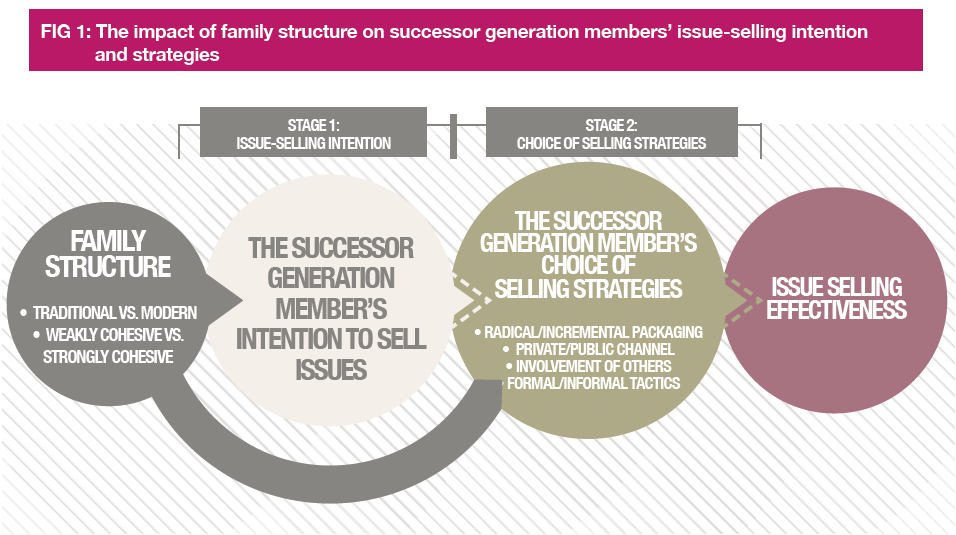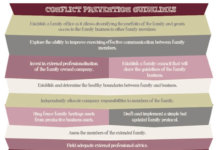Business transactions in some shape or form are the foundation of all societies…always have been and always will be. A closer examination reveals that these transactions revolve around some type of selling. Someone positions what he or she has in such a way that a buyer is motivated to purchase, or trade, something they have for this commodity. In this article Prof. Justin Craig, Northeastern University, USA, focuses on the selling of issues, which unlike the sale of services and products, can entail a significantly higher risk of conflict in the family business if mismanaged. In this article Prof. Craig specifically highlights how an understanding of the influence of family structures on issue selling intentions and strategies within the context of multi-generational family businesses has the potential to reduce conflict within and between generations.
This article has its geneses in a research paper co-authored by Yan Ling, David Baldridge and Justin Craig titled “The impact of family structure on issue selling by successor generation members in family firms” which appeared in Journal of Family Business Strategy, 3(4), 220-227.
On issue selling as a concept
Issue selling is a concept introduced by management scholars to define discretionary behaviour used to direct decision-makers’ attention toward important issues. Within an organisation individuals have to sell their issues upwards convincing their superiors, downwards to gain followers as well as sideways to gain support. At the core of the success of a sale lies the preparation of the individual to deal with conflicts that may arise when different points of view are articulated.
As the structure of a family business is arguably more complex than a ‘typical’ hierarchy in the modern organisation, there are considerably more moving parts involved in issue selling. As most family business stakeholders would agree, getting those parts to move at all, let alone move coherently, can be problematic. We will here primarily focus on the issue-selling behaviour of family business successors to the generation currently in charge.
[ms-protect-content id=”4069, 4129″]
The influence of family structures
Many factors have the potential to influence a successor generation member’s issue selling behaviours. One potentially dominant influence of how issues are framed and sold is centred on the structure of the family. Researchers[1] have identified several types of family structures based on cohesiveness and preferred communication style, autonomy versus interdependence, conflict-involvement versus conflict-avoidance, and convention versus tradition. We here highlight the factors of power and cohesion:
1. Power:
Fundamentally, power is the ability of one person to change the attitudes, opinions or behaviours of others. When applied to how power is distributed in family relationships, researchers have described family structures on a continuum ranging from traditional to modern[2].
In traditional families: Power distribution is shaped by the form of a patriarchal structure where one of the parents (usually the father) is considered the head of the family and decisions are typically made autonomously by this family member[3].
In modern families: Here there is a high degree of joint participation in carrying out tasks and decision-making. In this type of family, the power distance between parents and children is smaller.
2. Cohesion:
Cohesion is defined as “the emotional bonding that family members have towards one another”.
In cohesive families: A higher degree of cohesion is generally associated with a more harmonious family life and less egoistic decision making by family members.
In weakly cohesive families: A lower degree of cohesion is associated with higher levels of emotional distance where family members prefer to be separated, pursue their own interests, and are less likely to turn to one another for support.
The distribution of power and extent of cohesion help better understand the family structure’s potential influence on (1) intentions to sell issues, and (2) the choice of selling strategies.
Three factors influencing intentions to sell issues
Selling the “right” issue at the “right” time and in the “right” way can bring personal benefits. But selling an issue that is seen as inappropriate or detrimental to the organisation can damage a seller’s reputation and cause conflict. Issue selling also requires significant time and energy. The potential benefits and costs may leave sellers ambivalent.
An individual’s level of motivation to sell issues is based on their perception of the organisational context whereby three contextual cues play a known role:
1. Perceived organisational support for issue selling:
This perceived support includes both formal (e.g., a mechanism that ties employees’ compensation or promotion to their issue selling behaviour) and informal support (e.g., an organisational norm supporting issue selling). When such support exists and expectations are clear, it can provide a degree of psychological safety, and they may even create incentives for issue selling.
2. Perceived openness of management:
It is generally believed that the perception that someone will listen should contribute to a general sense of context favourability and thus motivates issue-selling behaviours.
3. Quality of relationships:
When the relationship between issue seller and recipient is perceived as trusting and friendly, it contributes to a sense of security. This strengthens potential sellers’ belief that selling attempts will receive serious consideration, which in turn promotes an intention to sell.
Case – Part 1
Consider the situation of a third-generation family in the tourism industry. The family business had been handed over to the third generation and consisted of fourteen cousins, four from one family and ten from the other. The Chief Executive Officer (CEO) was the eldest son of the four-member family. Two of his brothers and two cousins were employed full-time in the business while three others were employed on a part-time basis.
Overall, the transition of management and control between the second and third generation had been smooth. The issue that dominated any disagreement within the cousin consortium concerned decisions to grow the business by pursuing opportunities closely related to, but not core, to their current business activity. The CEO had identified that in order to remain successful and provide ongoing dividends for the growing family, the business needed to expand. Many of his cousins and his aunt did not share his entrepreneurial vision. They were suspicious of his motives and thought he did not have the same approach to risk as they did. Further, as many of the third generation had begun to have families of their own, the wives and husbands who had married into the family were adding their opinions to family business matters because their children would eventually be stakeholders in the business. The matriarch of the branch of the family that had ten family members (the CEO’s aunt) was also concerned that, as her husband was deceased, her decedents would not have the same voice in the family business as their cousins. Moreover, full-time employees (family members) were ‘given more say’ that those who did not work full time in the business were not. This situation had been generating conflict between second and third generation family members (siblings and cousins, uncle and aunts). Because of the different factions that had developed, family in-fighting delayed crucial decisions that affected the operation of the business, particularly concerning growth strategy options offered by the visionary CEO.
Though the CEO faced considerable push back and several of his relations were subtly, if not openly, conflictual, he was able to ultimately able to sell his issue (i.e., the need to consider growth opportunities outside their core business). Linking back to the previously introduced contextual cues relating to family structure, he achieved this positive outcome due to his being patient and developing a supportive environment for selling issues, the general acceptance by family and non-family management of new ideas, and the generally solid relationship he enjoyed with his family members.
Family structure and choice of issue selling strategies
Once the decision to sell an issue is made, sellers must decide how to approach the selling process; how to pick a strategy[4]. As shown in Figure 1, sellers’ strategies are defined by four basic options, which are examined in order to explore the potential impact of family structure at the second stage of issue selling.
1. Packaging:
The first selling strategy is packaging, which refers to decisions about how to frame or present an issue linguistically[5].
In traditional families: Decision-making is seen to be the purview of parents[6]. It is reasonable to assume that the successor generation in such families will exert more effort to appear non-aggressive, so as to minimise targeted incumbents’ negative perception of their behaviours and maximise the possibility of acceptance. This goal of appearing less aggressive should stimulate the successor generation members to package an issue as incremental rather than radical.
In modern families: Decision-making is seen less as the exclusive purview of parents. Thus, children in these families should be less concerned whether their behaviour threatens the incumbent’s authority. Radical framing of issues is potentially more likely to gain incumbent’s attention and thereby improve the probability of issue selling success.
2. Cohesiveness
Cohesiveness is also likely to influence successor generation members’ packaging of issues.
In cohesive families: Successor generations in firms with strongly cohesive family structure are more likely to package issues as a series of smaller sub-issues.
In weakly cohesive families: Successors are expected to focus more on task accomplishment and be less concerned about “offending” their parents[7]. When the change proposed is radical, they are apt to present it accordingly, instead of deliberately making it seem incremental.
3. Channels
Compared to packaging, selling channels relate more to the social psychological mechanics of issue selling. Selling channels may be public (such as weekly staff meetings, monthly strategy meetings, annual stockholder meetings) or private (such as private meetings with one or a few relevant top managers, or one-on-one appeals to the seller’s boss). Public channels often carry more personal risks, such as being associated with negative issues or organisational difficulties, particularly if top management pays little attention. But, public channels may also be a source of organisational legitimacy, increasing the likelihood that issues are seen as important[8].
In traditional families: Private channels are arguably more likely to be used because of perceived power hierarchy and role differentiation. Children from traditional families can be expected to be less confident regarding their ability to succeed in upward influence in family firms. Such negative expectations should motivate the successor generation members to approach issue selling more cautiously by using private selling channels; in so doing, they can save the public embarrassment for themselves, and even for the incumbents, when the issue sold is not well received.
In modern families: The relationships between family members and generations are more egalitarian[9]. In this case, the successor generations will be more optimistic on their upward influence success.
In cohesive families: In firms with strongly cohesive family structures, issue selling—which has the risk of being seen as a form of criticism of the official strategy—is likely to be seen as an insult to incumbents. As such, the successor generation members in this type of family firm are more likely to sell an issue in private to avoid the awkwardness that public selling might bring to parents.
In weakly cohesive families: The successors care less about others’ feelings than their own public image, and may prefer selling in front of others (public channel) in order to increase the likelihood of being heard and achieving enhanced image (e.g., being creative). The strategy behind such behaviour is that the existence of an audience poses an impression-management burden on incumbents, and, in the seller’s mind, this increases the potential that the incumbent head will show openness and concern for the issue at hand.
4. Selling alone vs. selling together
Another component of issue selling strategy is the decision to sell an issue alone or to get others involved.
In traditional families: It is reasonable to assume that successor generation members in traditional family firms would feel a strong need to validate their behaviours when they try to provide inputs to incumbents. One means that can help them meet this goal is to involve peers in the selling process. Compared to selling alone, collective selling could demonstrate a broader base of support and thus indicate that an issue is important for top management to recognise and address. This is likely to alleviate the incumbents’ feeling that their authority is being threatened and thus they have less reluctance to listen.
In modern families: Since successor generation members have been socialised to feel free to speak out, they should take less special effort to justify their issue selling behaviours or craft an issue. Accordingly, they are more likely to sell the issue solely to save time and ensure the original purpose of the issue is presented to the incumbent.
In cohesive families: Such families take harmony maintenance as paramount and this may result in a sort of family imposed ‘group-think’[10] a situation where family members are hesitant to question ideas.
In weakly cohesive families: These tend to reward performance based on individual efforts; family members in such families are socialised to be eager to speak out and demonstrate their capability. In addition, family members in weakly cohesive families have been found to have higher levels of emotional separateness and be less willing to turn to one another for support.
5. Formality
The last issue selling strategy is formality, or whether the sellers’ influence attempt uses official processes and procedures. Formal tactics might involve making a scheduled presentation to top management, generating a report, or setting up private one-on-one meetings with others, whereas informal tactics might include personal appeals, discussions in halls, or behind-the-scenes negotiations. Most issue sellers use multiple strategies, but the socialisation in family decision-making process can be expected to shape successor generation members’ choice of strategies.
In traditional families: Parents not only emphasise authority, but they also expect children’s respect. Based on this, in traditional families, children are expected to act in ways that bolster their parents’ dignity. They are more likely to sell issues through formal tactics to show their respect.
In modern families: Successors may see no reason to adhere to or show undue respect for the family hierarchy. They are more likely to utilise informal selling strategies as they are more comfortable with informal interactions.
In cohesive families: The successor generation members in firms will be more likely to rely on informal tactics, which have been argued to be less aggressive and make a potentially sensitive issue appear less confrontational.
In weakly cohesive families: Family members are less concerned about one another’s feeling than their personal gain. Thus, successor generation members may perceive less risk associated with the use of formal issue selling tactics and, therefore, would use them more frequently.
Case – Part 2
The CEO of the third generation tourism business packaged his issue incrementally rather than radically. He had spent a considerable amount of time working under the mentorship of his parents and uncle and aunt and had earned a reputation with various influential stakeholders as a thoughtful leader with a commitment to orientating the family business for the long-term. He used a combination of private and public channels. Specifically, he undertook a rigorous feasibility planning process of the target entrepreneurial opportunity, which he presented to the family at a family council forum. Importantly, he involved family members in the development of this document prior to the formal presentation and distribution. Though he personally took full responsibility for the issue (to consider entrepreneurial opportunities outside the core business) he relied on input from appropriately experienced family members. Given the modern (rather than traditional) structure and generally strongly cohesive nature of his family, the involvement of an increasing number of families in the business, and the concurrent introduction of a more professional approach to business and family governance, the CEO relied on formal rather than informal processes and procedures to receive approval for his issue. Though robust discussion was encouraged, adopting a more formal approach to the selling of this issue minimised conflict.
Implications
In family businesses, issue selling is multi-faceted and, potentially, significantly more complex than in non-family involved firms. The discussion above suggests that family firms with modern family structures and strongly cohesive family structures are more likely to possess successor generation members that are active and skilled in upward influence, while firms with traditional family structures and weakly cohesive family structures are more likely to face a less vocal younger generation. Understanding these differences is beneficial for family members working in the business, those not working in the business, those marrying into the family business, non-family management, as well as trusted advisors who act in vital support capacities.
Studies have shown interesting differences between generations around issues of control, power, and competition, as the desires and agendas of generations diverge[11]. For instance, founding generation members typically focus on continuation of business as usual, protection of their hard-won achievements, and using existing expertise. Younger generations in contrast tend to desire greater autonomy and parental recognition. Failure to sufficiently communicate these conflicting interests across generations in a way that achieves a good balance will likely limit the level of individuation and maturation of the successor generation and prevent smooth ownership and control transfer from the incumbent to this successor generation. We suggest that an understanding of issue selling and successor generation influence in family firms requires incumbents’ examination of the family attributes behind the business and their awareness of its impact is paramount to avoid conflict. At the same time, it is implied that efforts by the older generation to express support for issue selling, to be open-minded and to establish an open culture in the family firm are likely to lower the successor generation’s concerns of speaking out, and these efforts should be particularly important in traditional and weakly cohesive families.
CITED WORKS
Aronoff, CE. 2004. Self-perpetuating family organization built on values, necessary condition for long-term family business survival. Family Business Review, XVII (1): 55-59.
Ashford, S.J., Rothbard, N.P., Piderit, S.K. and Dutton, J.E. 1998. Out on a Limb: The Role of Context and Impression Management in Selling Gender-Equity Issues, Administrative Science Quarterly, 43: 23-57.
Dutton, J.E. and Ashford, S.J. 1993. Selling Issues to Top Management, Academy of Management Review, 18: 397-428.
Dutton, J.E., Ashford, S.J., O’Neill, R.M. and Lawrence, K.A. 2001. Moves That Matter: Issue Selling and Organizational Change, Academy of Management Journal, 44(4): 716-736.
Dyer Jr. WG. 1988. Culture and continuity in family firms. Family Business Review, 1(1): 37-50.
Gersick, K.E, Davis, J.A., Hampton, M.M., & Lansberg, I. 1997. Generation to Generation: Life Cycles of the Family Business. Harvard Business School Press: Cambridge, MA.
Hagenaars, A. & Wunderink-Van Veen, S. 1990. Soo Gewonne Soo Verteert. Economics of the Household Sector, (in Dutch) Leyden: Stenfert Kroese.
Holdert, F. & Antonides, G. 1997. Family type effects on household members’ decision making. Advances in Consumer Research, 24: 48-54.
Janis, I. 1991. Groupthink. In B. M. Shaw (Ed.). Psychological dimensions of organisational behavior. New York: MacMillan.
Kirchler, E. 1989. Buying decisions in the private household (in German). Gottingen: Hubert & Co.
Ling, Y., Baldridge, D.,& Craig, J. B. (2012) The impact of family structure on issue selling by successor generation members in family firms. Journal of Family Business Strategy, 3(4), 220-227.
Olson, D. H., McCubbin, H., Barnes, H. L., Larsen, A. S., Muxen, M. J., & Wilson, M. A. 1989. Families: What makes them work? Beverly Hill, CA: Sage.
[1] Olson and colleagues, 1989
[2] Holdert & Antonides, 1997
[3] Kirchler, 1989
[4] Ashford et al, 1998
[5] Dutton & Ashford, 1993; Dutton et al., 2001
[6] Holdert & Antonides, 1997
[7] Holdert & Antonides, 1997
[8] Dutton & Ashford, 1993; Dutton et al., 2001
[9] Hagenaars & Wunderink-Van Veen, 1990
[10] Janis, 1991
[11] Aronoff, 2004; Dyer Jr., 1988; Gersick et al., 1997
Tharawat Magazine, Issue 21, 2014
[/ms-protect-content]













